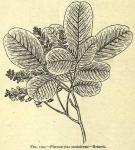 Related entry: Santalum album
Related entry: Santalum album
The heart-wood of Pterocar'pus santali'nus Linné.
BOTANICAL CHARACTERISTICS.—A large tree with dark red, heavy, and compact wood; a reddish juice exudes from its bark. Racemes axillary; flowers yellow,
streaked with red. Legumes orbicular.
HABITAT.—Madras.
DESCRIPTION OF DRUG.—In commerce usually in deep reddish-brown raspings or small chips, or a coarse powder; tasteless and nearly odorless. The wood consists mostly of the lower parts of the stem, and thick roots, imported in irregular logs of various sizes, usually deprived of the bark, and externally of a dark-brown color; internally of a rich red color, showing in transverse sections circles of a lighter tint. Used in Compound Tincture of Lavender.
Powder.—Microscopical elements of: See Part iv, Chap. I, B.
CONSTITUENTS.—The most important constituents are the red coloring matter, santalin, in needles, soluble in alcohol, ether, acetic acid, and alkaline solutions, but insoluble in water, and only slightly soluble in boiling water and santalic acid, C15H14O5. The yellow ethereal solution is turned to violet by alkalies. Santol, pterocarpin, and homopterocarpin are also constituents. Ash, not to exceed 3 per cent.
Preparation of Santalin.—Precipitate alcoholic tincture with lead acetate; decompose this precipitate with H2S in presence of alcohol and evaporate. Red needles are obtained, which are inodorous, tasteless, resinous; soluble in the alkalies with violet, and in ether with yellow color.
ACTION AND USES.—Of no value medicinally. Used in pharmacy for coloring preparations.
OFFICIAL PREPARATION.
Tinctura Lavandulae Composita.

